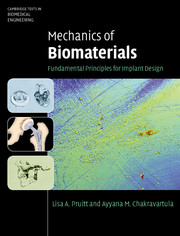Book contents
- Frontmatter
- Contents
- Symbols
- Prologue
- Part I Materials
- Part II Mechanics
- 6 Elasticity
- 7 Viscoelasticity
- 8 Failure theories
- 9 Fracture mechanics
- 10 Fatigue
- 11 Friction, lubrication, and wear
- Part III Case studies
- Epilogue
- Appendix A Selected topics from mechanics of materials
- Appendix B Table of material properties of engineering biomaterials and tissues
- Appendix C Teaching methodologies in biomaterials
- Glossary
- Index
- References
10 - Fatigue
from Part II - Mechanics
Published online by Cambridge University Press: 05 June 2012
- Frontmatter
- Contents
- Symbols
- Prologue
- Part I Materials
- Part II Mechanics
- 6 Elasticity
- 7 Viscoelasticity
- 8 Failure theories
- 9 Fracture mechanics
- 10 Fatigue
- 11 Friction, lubrication, and wear
- Part III Case studies
- Epilogue
- Appendix A Selected topics from mechanics of materials
- Appendix B Table of material properties of engineering biomaterials and tissues
- Appendix C Teaching methodologies in biomaterials
- Glossary
- Index
- References
Summary
Inquiry
How would you safely design a femoral component of a total hip replacement to prevent fatigue fracture of the stem without causing stress shielding to the adjacent bone?
The inquiry posed above represents a realistic design challenge that one might face in the field of orthopedics. Stress shielding is defined as bone loss that is owed to insufficient stress transfer from the implant to the neighboring bone. Stress shielding can be minimized through a combination of material selection and device design that provides improved compliance match to the tissue. Device design is a multifactorial process and it is equally important to ensure that the femoral stem is able to safely provide the requisite fatigue properties for successful performance of the implant. For a total hip replacement to function for two decades, the femoral component should offer a minimum of 20 million fatigue cycles to provide the estimated one million walking cycles per year for an average person. This fatigue life is further complicated by the anatomy, weight, health, and physical activity of the specific patient. The performance in vivo also depends on factors such as surgical placement and tissue healing as well as immunological response to the material. In order to design a fatigue-resistant implant, one would want to know the magnitude and nature of the expected stresses in the implant. For example, the implant may experience a combination of tensile, compressive, and bending stresses that are cyclic in nature. At a minimum, the peak stress ranges in the femoral stem should be below the endurance limit for the material and mean stresses should be incorporated into the life calculations. Further, the design should mitigate the use of sharp corners or other stress concentrations that can lead to fatigue crack propagation and fracture; if these elements exist within the design, then the fatigue life should be estimated conservatively using fracture mechanics methodologies.
Overview
Fatigue damage and associated failures are of critical concern to the medical device community as sustained loading of structural implants is inevitable. There are numerous cases of fatigue failures in medical devices owing to poor material selection, unsuitable sterilization methods, deficiencies in manufacturing processes, careless designs with inherent stress concentrations or crack initiating sites, and insufficient stress analysis given the complex multiaxial stresses of the body. The case example at the end of this chapter highlights a fatigue failure owing to the coupling of a poor component design and a material with inferior fatigue resistance.
- Type
- Chapter
- Information
- Mechanics of BiomaterialsFundamental Principles for Implant Design, pp. 329 - 368Publisher: Cambridge University PressPrint publication year: 2011



